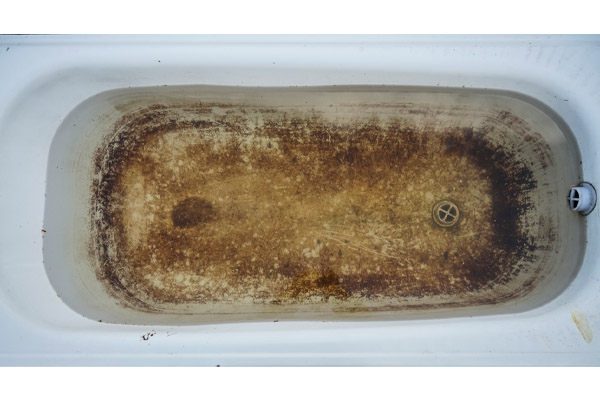Do you find yourself looking for facts around Why is There Sewage Coming Up Through the Bathtub?

Sewage backup in the bathtub can be an upsetting and unhygienic trouble for any homeowner. Not just is it troublesome, yet it additionally presents severe health risks and suggests underlying issues with the plumbing system. Understanding why sewer is turning up via the bath tub is essential for taking appropriate action to address the problem effectively.
Introduction to the Concern
Usual Reasons for Sewage Back-up
Clogs in the Sewage System Line
Among the most typical sources of sewer back-up is a clog in the sewage system line. This can occur because of the accumulation of particles, oil, or international things in the pipelines, preventing correct flow and causing sewer to back up right into your bathtub.
Tree Origin Intrusion
Tree origins seeking dampness and nutrients can penetrate drain lines via small splits or joints. In time, these origins can grow and broaden, creating significant damages to the pipelines and resulting in sewer backup issues.
Understanding the Issue
When sewage starts backing up into the bath tub, it's a clear indication of an issue with the drain system. The wastewater that must be moving far from your home is rather finding its way back into your home, which can lead to considerable damages and carcinogen.
Prospective Causes
A number of aspects can contribute to sewage back-up in the bath tub. From clogs in the sewer line to issues with the plumbing framework, recognizing the origin is essential for locating a remedy.
Aging Infrastructure
Older homes might have dated plumbing systems that are much more vulnerable to deterioration, splits, and damage. As pipelines age, they become more vulnerable to leakages and obstructions, boosting the probability of sewage backup cases.
Heavy Rainfall or Flooding
During durations of heavy rainfall or flooding, the drain system may end up being overwhelmed with excess water, creating back-ups and overflows. This can result in sewage supporting right into bathtubs and other fixtures inside the home.
Indicators of Sewer Back-up
Foul Odors
Unpleasant odors originating from drains or components, specifically in the washroom, might indicate sewage backup issues. These odors are commonly strong and relentless, signaling an issue that needs immediate interest.
Slow Draining Fixtures
Bathtubs, sinks, and bathrooms that drain pipes gradually or otherwise in all could be experiencing sewer backup. If several fixtures are affected at the same time, it's likely that the concern stems from a common point, such as the main sewage system line.
Gurgling Sounds
Unusual gurgling or gurgling noises originating from drains when water is running somewhere else in the house are a sign of air entraped in the plumbing system. This air accumulation can arise from sewage back-up and ought to be explored quickly.
Wellness Risks Connected With Sewer Backup
Contamination of Supply Of Water
Sewage back-up can pollute the water supply in your house, positioning a serious health threat to you and your family members. Exposure to contaminated water can cause intestinal issues, skin infections, and various other health problems.
Mold Development
Moisture from sewer backup can develop optimal conditions for mold and mildew growth in your house. Mold and mildew spores can exacerbate respiratory issues and create allergic reactions in delicate individuals, making timely clean-up important.
Spread of Condition
Sewer includes harmful germs, infections, and bloodsuckers that can cause a variety of conditions, consisting of liver disease, cholera, and gastroenteritis. Coming into contact with sewage or infected surfaces puts you in danger of infection.
Tidying up After Sewer Backup
Disinfection Procedures
Completely disinfect and sanitize influenced locations after sewage back-up to get rid of hazardous microorganisms and prevent mold growth. Use appropriate cleansing products and protective equipment to make certain risk-free and effective clean-up.
Repair of Affected Locations
Repair any damages to flooring, wall surfaces, or fixtures brought on by sewage back-up. Depending on the degree of the damage, you might need to change carpets, drywall, or other products to recover your home to its pre-loss problem.
Immediate Actions to Take
Switching Off Water
In case of sewer back-up, it's vital to turn off the water supply to avoid more contamination and damage. Situate the primary water shutoff valve in your house and closed it off until the problem can be settled.
Calling a Specialist Plumber
Dealing with sewage backup is not a DIY job. Contact a certified plumber with experience in managing sewage-related problems to assess the scenario and carry out necessary repair services or cleanups.
Preventing Contact with Contaminated Water
Up until the sewage backup is dealt with, stay clear of contact with contaminated water to prevent the spread of bacteria and microorganisms. Wear protective equipment if you should be in the damaged location and clean your hands completely afterward.
Preventive Measures
Regular Maintenance of Sewer Lines
Schedule regular evaluations and maintenance of your sewage system lines to determine and deal with possible problems prior to they escalate into major issues. This can consist of clearing out debris, checking for tree origin intrusion, and repairing any kind of damaged pipelines.
Mounting Backwater Shutoffs
Think about setting up bayou valves in your plumbing system to avoid sewer from receding right into your home throughout periods of heavy rainfall or flooding. These shutoffs immediately close when water starts backing up, shielding your building from contamination.
Correct Disposal of House Waste
Avoid flushing anything besides toilet tissue and human waste down the bathroom to prevent blockages and obstructions in the sewer line. Dispose of grease, oil, and other family chemicals correctly to minimize the danger of plumbing troubles.
Why Is Water Backing Up in My Bathtub When I Flush My Toilet?
What to do about a sewer line clog
First, don’t bother with plunging. No amount of plunging will dislodge the clog in a sewer line. The clog is too far away. Plungers are for clogs in the toilet itself, not the sewer line. Plus, the most likely causes of a sewer clog are:
Tree roots Flushed toys or feminine products Grease buildup Those items don’t move easily. And in the case of tree roots, the roots need to be cut out of the pipe and the pipe will need to be repaired.
You’ll need a closet auger. A closet auger is a type of plumber’s snake with a protective cover to keep from scratching the delicate porcelain toilet. If the clog is further down, you may need to remove the toilet or use one of your cleanouts to get to the clog.
We also recommend doing a video inspection of the drain to ensure that the cause of the clog has been completely removed. Otherwise, you could have the same problem again in a few days or weeks.
https://mspplumbingheatingair.com/blog/why-is-water-backing-up-in-my-bathtub-when-i-flush-my-toilet

We were shown that article on from someone on a different site. Sharing is good. Who knows, you may just be doing someone a favor. Thank you for being here. Return soon.
Prices & Booking